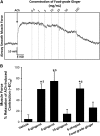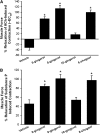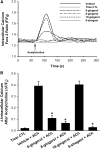Effects of ginger and its constituents on airway smooth muscle relaxation and calcium regulation
- PMID: 23065130
- PMCID: PMC3604064
- DOI: 10.1165/rcmb.2012-0231OC
Effects of ginger and its constituents on airway smooth muscle relaxation and calcium regulation
Abstract
The prevalence of asthma has increased in recent years, and is characterized by airway hyperresponsiveness and inflammation. Many patients report using alternative therapies to self-treat asthma symptoms as adjuncts to short-acting and long-acting β-agonists and inhaled corticosteroids (ICS). As many as 40% of patients with asthma use herbal therapies to manage asthma symptoms, often without proven efficacy or known mechanisms of action. Therefore, investigations of both the therapeutic and possible detrimental effects of isolated components of herbal treatments on the airway are important. We hypothesized that ginger and its active components induce bronchodilation by modulating intracellular calcium ([Ca(2+)](i)) in airway smooth muscle (ASM). In isolated human ASM, ginger caused significant and rapid relaxation. Four purified constituents of ginger were subsequently tested for ASM relaxant properties in both guinea pig and human tracheas: [6]-gingerol, [8]-gingerol, and [6]-shogaol induced rapid relaxation of precontracted ASM (100-300 μM), whereas [10]-gingerol failed to induce relaxation. In human ASM cells, exposure to [6]-gingerol, [8]-gingerol, and [6]-shogaol, but not [10]-gingerol (100 μM), blunted subsequent Ca(2+) responses to bradykinin (10 μM) and S-(-)-Bay K 8644 (10 μM). In A/J mice, the nebulization of [8]-gingerol (100 μM), 15 minutes before methacholine challenge, significantly attenuated airway resistance, compared with vehicle. Taken together, these novel data show that ginger and its isolated active components, [6]-gingerol, [8]-gingerol, and [6]-shogaol, relax ASM, and [8]-gingerol attenuates airway hyperresponsiveness, in part by altering [Ca(2+)](i) regulation. These purified compounds may provide a therapeutic option alone or in combination with accepted therapeutics, including β(2)-agonists, in airway diseases such as asthma.
Figures







Similar articles
-
Active components of ginger potentiate β-agonist-induced relaxation of airway smooth muscle by modulating cytoskeletal regulatory proteins.Am J Respir Cell Mol Biol. 2014 Jan;50(1):115-24. doi: 10.1165/rcmb.2013-0133OC. Am J Respir Cell Mol Biol. 2014. PMID: 23962082 Free PMC article.
-
Ginger metabolites and metabolite-inspired synthetic products modulate intracellular calcium and relax airway smooth muscle.Am J Physiol Lung Cell Mol Physiol. 2021 Nov 1;321(5):L912-L924. doi: 10.1152/ajplung.00271.2021. Epub 2021 Sep 22. Am J Physiol Lung Cell Mol Physiol. 2021. PMID: 34549600 Free PMC article.
-
Effects of ginger constituents on the gastrointestinal tract: role of cholinergic M3 and serotonergic 5-HT3 and 5-HT4 receptors.Planta Med. 2011 Jul;77(10):973-8. doi: 10.1055/s-0030-1270747. Epub 2011 Feb 8. Planta Med. 2011. PMID: 21305447
-
Protective and therapeutic potential of ginger (Zingiber officinale) extract and [6]-gingerol in cancer: A comprehensive review.Phytother Res. 2018 Oct;32(10):1885-1907. doi: 10.1002/ptr.6134. Epub 2018 Jul 16. Phytother Res. 2018. PMID: 30009484 Review.
-
Occurrence, biological activity and metabolism of 6-shogaol.Food Funct. 2018 Mar 1;9(3):1310-1327. doi: 10.1039/c7fo01354j. Epub 2018 Feb 8. Food Funct. 2018. PMID: 29417118 Review.
Cited by
-
Assessment of some quality parameters and chemometric-assisted FTIR spectral analysis of commercial powdered ginger products on the Ghanaian market.Heliyon. 2022 Mar 22;8(3):e09150. doi: 10.1016/j.heliyon.2022.e09150. eCollection 2022 Mar. Heliyon. 2022. PMID: 35846447 Free PMC article.
-
Ginger and its bioactive component 6-shogaol mitigate lung inflammation in a murine asthma model.Am J Physiol Lung Cell Mol Physiol. 2020 Feb 1;318(2):L296-L303. doi: 10.1152/ajplung.00249.2019. Epub 2019 Dec 4. Am J Physiol Lung Cell Mol Physiol. 2020. PMID: 31800263 Free PMC article.
-
Molecular Regulation of Toll-like Receptors in Asthma and COPD.Front Physiol. 2015 Nov 9;6:312. doi: 10.3389/fphys.2015.00312. eCollection 2015. Front Physiol. 2015. PMID: 26617525 Free PMC article. Review.
-
Traditional Medicinal Plants Conferring Protection Against Ovalbumin-Induced Asthma in Experimental Animals: A Review.J Asthma Allergy. 2021 Jun 14;14:641-662. doi: 10.2147/JAA.S296391. eCollection 2021. J Asthma Allergy. 2021. PMID: 34163178 Free PMC article. Review.
-
Quercetin acutely relaxes airway smooth muscle and potentiates β-agonist-induced relaxation via dual phosphodiesterase inhibition of PLCβ and PDE4.Am J Physiol Lung Cell Mol Physiol. 2013 Sep;305(5):L396-403. doi: 10.1152/ajplung.00125.2013. Epub 2013 Jul 19. Am J Physiol Lung Cell Mol Physiol. 2013. PMID: 23873842 Free PMC article.
References
-
- Singh BB, Khorsan R, Vinjamury SP, Der-Martirosian C, Kizhakkeveettil A, Anderson TM. Herbal treatments of asthma: a systematic review. J Asthma 2007;44:685–698 - PubMed
-
- Kao ST, Chang CH, Chen YS, Chiang SY, Lin JG. Effects of Ding-Chuan-Tang on bronchoconstriction and airway leucocyte infiltration in sensitized guinea pigs. Immunopharmacol Immunotoxicol 2004;26:113–124 - PubMed
-
- Li A, Xie Y, Qi F, Li J, Wang P, Xu S, Zhao L. Anti-virus effect of traditional Chinese medicine Yi-Fu-Qing granule on acute respiratory tract infections. Biosci Trends. 2009;3:119–123 - PubMed
Publication types
MeSH terms
Substances
Grants and funding
LinkOut - more resources
Full Text Sources
Other Literature Sources
Research Materials
Miscellaneous

